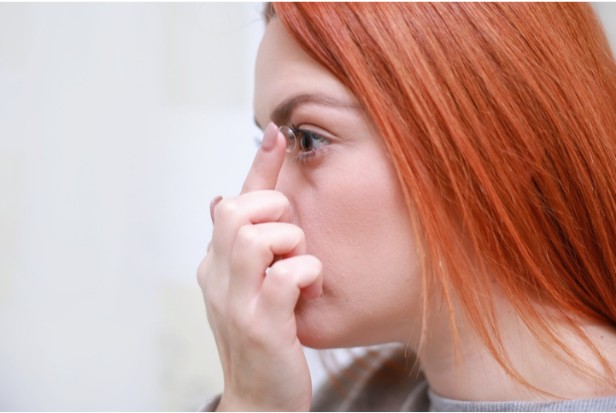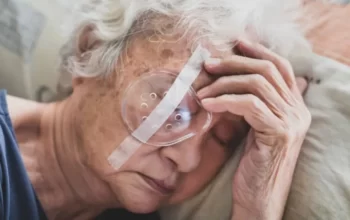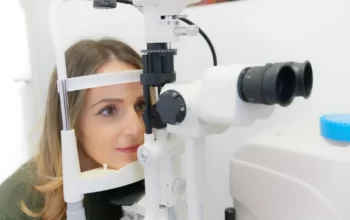
The type of lenses you have will determine how long you can wear them, but in general, it is recommended that you wear your contact lenses for 8 to 12 hours per day. When it comes to wear time, colored contact lenses adhere to the same guidelines as clear contact lenses.
How Long Can You Wear Clear Or Colored Contact Lenses For?
Colored contact lenses can be worn in a variety of ways, just like regular contacts. Both daily and monthly colored lenses are available from the most well-known brands.
How Long Can You Wear Daily Contact Lenses For?
Daily disposable lenses are made to be used only once and should be thrown away at the end of the day. Not more than 10 to 12 hours per day should be spent wearing contact lenses. Due to their high-water content some people who suffer from dry eyes find daily lenses are easier to wear for longer periods of time
How Long Can You Wear Monthly Or Yearly Contact Lenses For?
Contact lenses are worn for the day and cleaned and stored at night if they are worn monthly or annually. Depending on the brand and lifespan of the lenses as well as how well they are cared for, a pair can be reused for a number of years. Up to nine hours per day should be spent wearing monthly or annual contacts.
How Long Can You Wear Extended Wear Contact Lenses For?
Contact lenses designed for extended wear can be wore all day and even overnight. The amount of time you can go without removing these lenses depends on the manufacturer, but it is always advisable to try to give your eyes a break or disinfect by cleaning them with contact lens solution for at least twice a week. You should never wear lenses continuously for more than 30 days.
How Long Does a Pair of Contact Lenses Last?
Another question that can be addressed by the aforementioned information, but to be more precise, is that there are various replacement cycles that can be selected from, including daily or one-day disposable, biweekly or two-week disposable, monthly, quarterly or three months, and yearly. The replacement cycle you should choose will depend on your budget and should be suggested by your optometrist. In general, daily disposable contact lenses are the most hygienic option because you only wear them once and discard the lenses at the end of the day. Reusable contact lenses are more cost-effective because you can keep and reuse them, but you must make sure you follow the proper cleaning and storing instructions to ensure comfort and quality while wearing them repeatedly.

How Much Do Coloured Contact Lenses Cost?
The price of colored contact lenses varies depending on the brand and whether you wear them daily or monthly.
FreshLook One Day, a well-known brand of daily lenses, is only £11.95 on Vision Direct. The most practical option is to use these disposable lenses since you won’t need to soak them in a solution to store them overnight.
Those who want to incorporate the enhancement into their daily lives should use monthly colored lenses. They are more affordable than daily disposable lenses, just like corrective contact lenses. If you don’t mind storing your monthly lenses in the solution each night, you can wear them for 30 days in a row. There are many well-known monthly colored contacts available, including FreshLook Colorblends for only $14.99 and Air Optix Colors for only $16.99. Choosing your product is entirely a matter of personal preference because every product has a unique effect.
Visit the relevant section of our online store to find out more about the full selection of colored contact lenses offered by Vision Direct.
Problems Caused by Wearing Expired Contacts
There are several dangers connected to using outdated contact lenses. Two of the main reasons why contact lens users get eye infections are improper lens hygiene and disregarding expiration dates. Poor contact lens hygiene is a significant risk factor for a variety of eye conditions, according to the Centers for Disease Control and Prevention (CDC).
Problems associated with wearing expired or poorly cared for contacts include:
- injury to the corneal surface.
- moderate to severe eye pain.
- Sensitivity to light.
- Red eye.
- loss of vision, whether partial or total.
- Infection.
- Scarring.
Approximately 99 percent of people who wear contacts admit to engaging in at least one contact lens hygiene practice that raises their risk of inflammation or infection of the eye, according to the CDC. A whopping 40 to 90% of people who wear contacts don’t take care of them as recommended. The painful eye infection known as keratitis, which is primarily linked to improper contact lens use, causes close to 1 million doctor visits annually.
Types of Contacts & Their Expiration
Considering that the U.S. has about 45 million residents. who wear contact lenses, it is no surprise that many different types of contact lenses have been developed. The FDA explains that there are a few main categories of contact lenses.
Types of contact lenses include:
- Soft contacts. These lenses, which come in disposable and extended wear varieties, are made of soft, flexible plastics to allow oxygen to pass through to the cornea. In comparison to rigid lenses, they are more comfortable and relatively simple to adjust to.
- rigid gas permeable (RGP) lenses RGP lenses are more reliable and resistant to the buildup of deposits despite being more rigid than soft lenses. Vision is usually clearer as a result.
- contacts that last a long time. These lenses, which are made for overnight or continuous use, can be worn for up to a month during the day or for one to six nights. The majority of them are soft contact lenses, but some RGP lenses have been approved for overnight wear.
- Disposable contacts. Disposable contacts are those that are intended to be used just once before being thrown away, according to the FDA. Lenses are designed to be worn every day and should be brand new.
- Schedule contacts for replacements. Replacement schedule lenses are intended to be worn for a predetermined amount of time, such as one day, two weeks, or one month. For the allotted amount of time, the lenses may be worn continuously; after that, they must be discarded.
- Decorative contacts. Wearing decorative lenses for cosmetic or costume purposes is subject to the same rules and guidelines for contact lens care and expiration. Regardless of whether you require them for vision correction or not, you should still use a prescription to purchase decorative lenses.
How Firm is the Expiration Date?
The use of contacts before they expire is advised by eye care professionals. When contacts are past their expiration date, even unopened ones can become bad. A solution that serves as a preservative and is used to pack contact lenses has an expiration date. By that time, it is unable to maintain the contacts’ sterility and safety for use.
Many contacts have lengthy expiration dates of up to a few years. It is advised to avoid using lenses that were produced more than a few years ago. Your risk of developing an eye infection and other complications significantly rises when you use contact lenses that have passed their expiration date.
If you are worried about throwing away contacts that are close to expiring, eye care professionals advise using your lenses in chronological order, as long as none of them are actually past their expiration date. In this manner, outdated lenses won’t be overlooked or end up needing to be thrown away.
How Do I Find My Expiration Date?
Contact lens expiration dates are typically printed on the containers of each individual lens. The foil cover of your container contains the date that your pair of lenses expires. You can also find other information about your lenses here, including:
- Lens’s brand name
- Manufacturer name
- Lens diameter
- Contact lens material
- Lot number
- Base curve of the lens
- And most importantly, the expiration date
You can start by getting in touch with your eye doctor’s office if you can’t for some reason find the date that your contacts expire. The technicians there should be able to respond to your inquiry or else direct you to the manufacturer to assist you in locating the date you need.
Before purchasing or using any contact lenses, it is crucial to verify the expiration date. Future complications like infections in the eyes or other problems with your eye health could be avoided by doing this.
What to Do If You’ve Been Wearing Expired Contact Lenses
Several negative ocular health effects can result from using expired contacts. The preservation solution for the lenses will probably become contaminated with fungi, bacteria, and amoebae after the expiration date has passed. These pathogens may raise your risk of getting sick, feeling uncomfortable, and possibly losing your sight permanently.
The best course of action to take when you realize your contacts have run out of time is to visit your eye doctor right away.
What to Do If Your Contact Lens Solution Expires
You should not wear contact lenses if you discover that the solution has run out. Instead, you can ask your eye doctor for guidance on the best course of action. Most likely, your doctor will advise you to get fresh, safe-to-use contacts that have not yet expired.
Even if you practice good contact lens hygiene, their manufacturers recommend replacing them after a certain amount of time. Even with proper care, contact lenses may not always be safe to wear.
Proper Contact Use
The best way to prevent complications, such as infections brought on by your contacts, is to follow proper contact lens usage guidelines. The American Academy of Ophthalmology (AOA) recommends sticking to the following steps in order to avoid contact lens infections:
- When cleaning lenses, rub them to remove protein and bacterial buildup.
- Always rinse your contact lenses and keep them in contact lens solutions you can buy at the store.
- At least three times a year, change the contact lens case.
- Sometimes, particularly at night, allow your eyes to rest without contact lenses in them.
- If new contacts are advised, always purchase them. Don’t attempt to use them past their expiration date.
FAQs
How Long Do TTDeye Colored Contacts Last
Don’t worry about the comfort; it is 0.004mm thick and contains 38%–45% water. The period of use is 12 months, therefor, the care for it cannot be neglected.
How Long Do Contacts Last Unopened
A printed expiration date is on every package of contact lenses. In most cases, the expiration date is four years after the packaging date.
How Long Can You Wear Colored Contacts in a Day
Daily colored contacts are single-use, disposable lenses that must be removed from their solution before wearing. Once applied to the eye, you can wear the lenses for about 8 hours but this may vary with brands, so ensure you check the packaging for manufacturer recommendations.
How Long Can You Wear Contacts before Throwing Them Away
Wear contact lenses only as long as necessary. It is recommended to discard daily disposable lenses each day. After 14 days, a biweekly disposable lens should be discarded. After 30 days, monthly disposable lenses should be discarded.
How Long Do Contacts Last in Solution
There are many different contact lens care regimens, so it’s critical to understand how long contact lenses can be stored in a solution without risk before the solution needs to be changed. Some solutions can only store lenses for a day, while others can do so for up to a month.



